Hola todos,
Day 10 (Ew, David! and other stories)
I really wanted to check out a coffee shop known among tourists, especially Americans, as being a place to get good coffee with alternative milks (and at no upcharge!) So off to Coffee Mantra I went. I had an oat milk cappuccino to go so I could walk around the city while I caffeinated. (It was delightful!)
First was a stop at the Piazza della Annunciata and the Cappella di San Luca, also known as the Painter’s Chapel. The church had a relatively plain exterior with some beautiful courtyard frescoes.
But nothing could prepare me for the absolutely stunning and unbelievable interior:

This was easily the most beautiful church I've been to in Italy. (And maybe also of all time, but I'd really have to search my memory to be sure.) It was absolutely massive and totally breathtaking and I had to pick my jaw up off of the floor. The really shocking thing is that entry into this church is free, whereas so many other churches have costs a few euros to get inside. This one would be worth the entry fee.
Today's main attraction, though, was the Galleria dell’Accademia, which holds Michelangelo’s The David, and the crowds are insane accordingly. I had timed tickets that I purchased in advance, which was 100% the way to go. (And even if you have timed tickets, you’ll still wait 20-30 minutes to enter! The Galleria gets 1.5 million visitors per year.) I ended up purchasing the audio tour here, too, and I thought it was helpful.

This is the clay model of a statue in the Loggia that I saw a few days ago. It’s one of the oldest original models at one-to-one scale.



The Galleria also holds the Medici-Lorraine instrument collection, an incredible assortment.


It also holds a lot of incredible paintings. To be honest, though, I'm on a bit of a fine art overload.
These marble Michelangelo sculptures were meant for a pope’s tomb. They went unfinished after Michelangelo was retasked to a different project by the Vatican, and were renamed The Prisoners in the 19th century because they look like the sculptures are tortured prisoners trying to break out of the marble. Although they’re only rough drafts, they’re cool to see.
Two more Michelangelo's (casual) that were left undone:


Matthew (left) commissioned by city of Florence, and a Pieta.
Then I got to the exhibit’s highlight, The David:

Two other artists abandoned the stone that Michelangelo (in his late twenties) ended up turning into The David. He’s in the classic Renaissance pose: contraposto.
His head looks disproportionately large for his body because initially the statute was supposed to be on top of the Duomo's dome. Viewed from the ground, the head would appear to be in the right proportion. Otherwise, at over 5 meters tall, The David is anatomically perfect.
There were also a ton of busts and sculptures in another room, but even the sheer number of sculptures here couldn't get out from underneath Michelangelo's shadow. Quality over quantity makes a master, it seems.

After finishing up at the museum, I spent the rest of the afternoon in Oltrarno, seeing more of what Florence on the other side of the river had to offer.
The Basilica di Santo Spirito was a huge and spacious church with massive and beautiful wall panel paintings and a huge main altar. (They didn’t allow visitors to take photos inside, though.)

It was at this church were young Michelangelo studied anatomy: while it was forbidden to study human anatomy from corpses at the time, friars at this church supplied Michelangelo with bodies from the morgue.
And I walked up to and through the Piazzale Michelangelo. At the top, your efforts are rewarded with this stunning view of Florence. It’s the best free (well, €0–it costs some sweat!) view in the city for sure.
The gardens on the way up are beautiful, too!
Far-away Florence! While the downtown/touristy area is pretty compact, Florence spreads out quite far.
Sunset over Oltrarno.
I enjoyed another evening of perfect weather, people watching, and evening lights through the city.
Day 11 (Uffizi Gallery tour and more)
This morning started with the mandatory cappuccino (pretty sure my body composition is at least 20% espresso at this point) and a quiet breakfast outside of the Duomo. In the early mornings, it's quite peaceful before the masses of tourists arrive. (And it was a Saturday, which meant the crowds would be in full force.)
I had a guided tour this morning through the Uffizi Gallery, Italy's most-visited museum (since the Vatican is tallied separately as a different country). It is the biggest intact family collection (the Medicis, surprise surprise) in the world with over 100,000 pieces and 100 rooms. Julia, our tour guide, is an art historian and showed us the key pieces in the museum along with an explanation of their significance in art history. Andiamo!
The Uffizi (meaning "offices" in Italian) was the Medici's office space while they controlled the government. It was built on top of a church, meaning that the bathrooms in the lower levels of the building are actually in a former crypt. (Weird!)
The hallways are covered in artwork, with sculptures and portraits along the walls and frescoed ceilings hanging over visitors.
Over the next two hours, Julia gave us a rundown of Italian art history, the Renaissance, and the inner workings of art patronage during that period.
Botticelli's The Birth of Venus. This was the first female nude of the new art period. Venus portrays the beauty ideal of Renaissance Europe: light skin (which showed you were wealthy enough to avoid outdoor labor), light hair (died using horse urine! ew!), no brows or lashes, and a high forehead (often shaved).
Da Vinci was a student learning under an art master when this piece was made. The art master made the two main figures on the right, while Da Vinci painted the figures on the left. Da Vinci's use of light in the folds of the angels' fabric was so much better than his teacher's that, after painting this piece, his teacher never returned to painting and Da Vinci set off on his own. (Da Vinci was 17!)
This is a priceless Michelangelo painting because it is the only canvas painting we have from him. Michelangelo rarely painted and, when he did, painted on wood. The Uffizi doesn't even loan out the piece to other galleries or exhibits for this reason. The frame was made by his student(s) at the time, since it's carved wood and Michelangelo considered wood carving beneath him--true masters only carved marble.
The Ponte Vecchio and Oltrarno from an upper room of the Gallery. Quite a view!
After our walk through art history concluded, I walked around a little more to see a few more pieces but then headed off to lunch.
La Prosciutteria was another recommended spot to get
schiacciata, so I took it to the River Arno and had a picturesque picnic. (I thought SchiacciaVino from the other day was better, but this one was still very good.)
Refreshed, I walked over to the Santa Maria Novella pharmacy. It's a perfume and beauty store that is inside a former church and sacristy from the late 1300s. They've left many of the wall and ceiling frescoes as decorations, and it's a beautiful store. (The prices are a bit steep, though!)
You could get close enough to these frescoes to touch them. So cool!
I sat outside in the nearby piazza where families had gathered to enjoy the early evening and a musician was playing some beautiful guitar. I ended the evening by venturing back to Oltrarno to get some gelato and walk, once again, through Florence at night. What a delight it is to be here!
Besos,
Tina the ExploraDora
Cumulative steps: 242,379 steps

















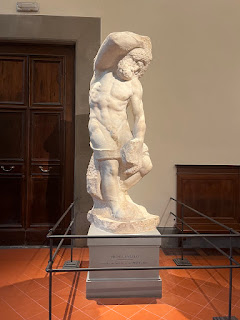








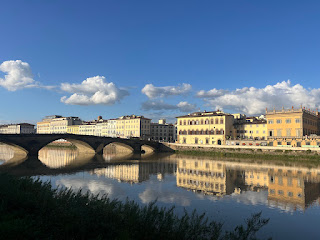




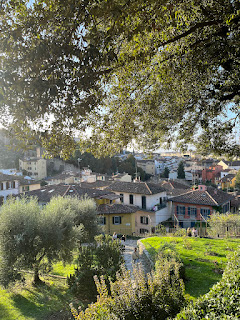



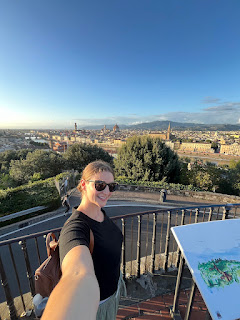





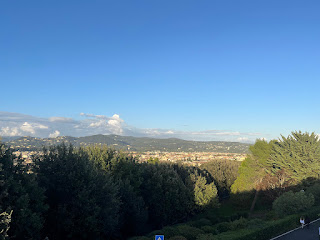


















No comments:
Post a Comment